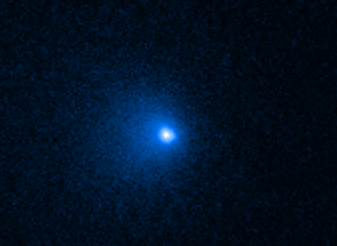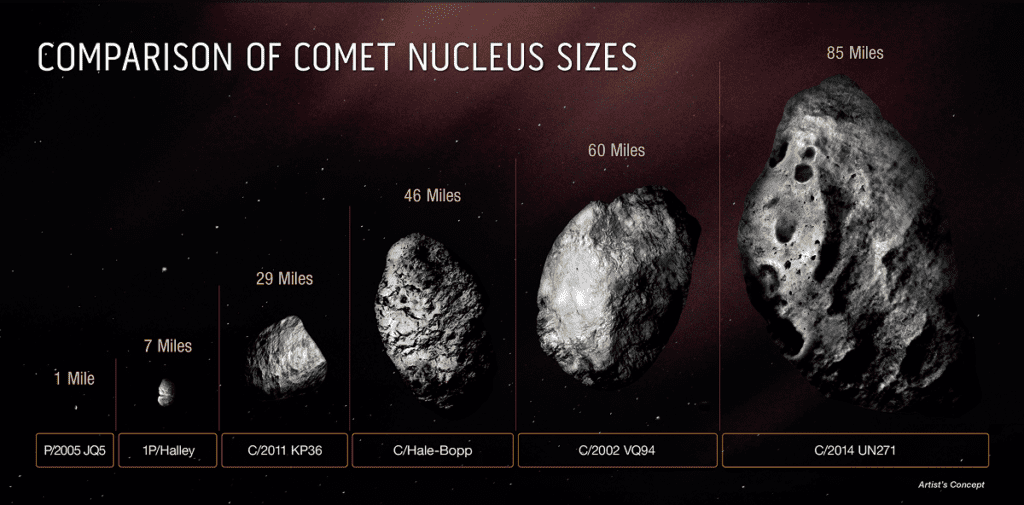A 4-billion-year-old relic from the early days of the solar system was spotted by Hubble heading in our general direction. But don’t get spooked — this isn’t a threat, it’s an opportunity to learn more about how our solar system came to be and evolved.

While the tails of comets can be very long, stretching to over 600,000 miles (1 million kilometers), the average comet has relatively small a nucleus less than six miles (10 kilometers). Now astronomers at the at the University of California, Los Angeles (UCLA) have found one heading in the direction of our Solar System with a nucleus which exceeds 80 miles (129 kilometers) across, roughly twice the width of the state of Rhode Island.
Using five photos from the Hubble Telescope on January 8, astronomers calculated that C/2014 UN271 (Bernardinelli-Bernstein) barreling its way at 22,000 miles per hour (35,406 kilometers per hour) from the Oort Cloud. Its mass is estimated to be 500 trillion tons, a hundred thousand times greater than the mass of a typical comet found much closer to the sun and the nucleus about 50 times larger than those of most known comets.
But before you start worrying, it won’t get any closer than one billion miles to the Sun (by comparison, that is approximately the distance from Earth to Saturn). So there’s no risk of a collision with Earth.

Comets, among the oldest objects in the solar system, are icy bodies that were unceremoniously tossed out of the Solar System in a gravitational pinball game among the massive outer planets. These evicted comets took up residence in the Oort cloud, a vast reservoir of far-flung comets encircling the solar system out to many billions of miles into deep space.
“This comet is literally the tip of the iceberg for many thousands of comets that are too faint to see in the more distant parts of the solar system,” said David Jewitt, a professor of planetary science and astronomy at UCLA, and co-author of the new study published in The Astrophysical Journal Letters. “We’ve always suspected this comet had to be big because it is so bright at such a large distance. Now we confirm it is.”
The massive comet was discovered by astronomers Pedro Bernardinelli and Gary Bernstein in archival images from the Dark Energy Survey at the Cerro Tololo Inter-American Observatory in Chile. C/2014 UN271 was initially observed in November 2010, when it was three billion miles (4.8 billion kilometers) from the Sun, which is nearly the average distance to Neptune.
“This is an amazing object, given how active it is when it’s still so far from the Sun,” said Man-To Hui, the paper’s lead author, of the Macau University of Science and Technology, Taipa, Macau. “We guessed the comet might be pretty big, but we needed the best data to confirm this.”
Measuring the comet took some work. The tricky bit was how to discriminate the solid nucleus from the enormous dusty coma surrounding it. The megacomet is currently too far away for its nucleus to be visually measured by Hubble. Instead, the Hubble data shows a bright spike of light at the nucleus’ location. The research team made a computer model of the surrounding coma and adjusted it to fit the Hubble images. Then, the glow of the coma was subtracted to leave behind the starlike nucleus.
Hui and his team compared the brightness of the nucleus to earlier radio findings from the Atacama Large Millimeter/submillimeter Array (ALMA) in Chile. This combined data constrains the diameter and the reflectivity of the nucleus. The new Hubble measurements are close to the earlier size estimates from ALMA, but convincingly suggest a darker nucleus surface than previously believed.
The previous record holder for size was comet C/2002 VQ94, with a nucleus estimated to be 60 miles (97 kilometers) across. It was discovered in 2002 by the Lincoln Near-Earth Asteroid Research (LINEAR) project.









